Intruders are never good. Their intent and presence could hardly be for your benefit. There are many ways of detecting intruders ranging from analogue and mechanical systems to high-tech and super sophisticated ones.
Every method has its pros and cons. I recommend a system that relies on a variety of high-tech and low-tech, as I think it’s better than one that depends on a single modality.
The system I will describe in this article combines motion and pressure sensors. I use this system to help guard the areas where my livestock sleeps at night. But you could use it anywhere that needs protection.
Combining Warning Systems
The motion sensor alerts you to the presence of a large moving body, and I use this as a perimeter monitoring feature.
Related: How to Harden Your Home Against Intruders
The pressure sensor is weight-activated and alerts you that someone or something is standing on or walking over the pressure pad. I bury the pressure pads below the sand in front of the access gates to the livestock pens.
Be Careful
For those of you who have no experience working with electricity, I would insist that you only undertake this project under the supervision of a qualified electrician or electrician’s assistant.
If you know your way around electricity, you should maintain all safety protocols required when working with electricity, including proper isolated tools, working on an earthed circuit and never working on live wires.
The thinking is as follows: Something sets off the motion sensor to alert me. It could be a predator or one of my animals that escaped its pen. I usually want to see if the motion sensor picks up something again before I go and look.
Remember that the pressure pad is outside the gate. When both the pressure pad and motion sensor are activated, you know it’s time to respond.
Choke points
I do something similar around what I call choke points. These are points of access through which people creeping up on my homestead would pass.
⇒ Do You Know Why You Should Never Put A Tall Fence Around Your House?
The same principle applies in that the motion sensor is the first line of early warning, and the pressure pad is a confirmation that something is heading in my direction.
Components required
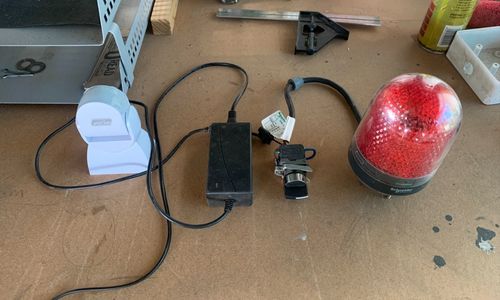
- Motion sensor – I use a shop-bought dedicated motion sensor.
- Pressure Pad – How to make one will be detailed below.
- Alarm – I use an industrial signal light and sound alarm combination powered by a 12V DC transformer.
- Wiring – I use three-core, and two-core wiring, in the 2,5 to 1mm range
Circuits
The system contains two separate circuits that each activate the alarm.
- Circuit 1 – Motion sensor circuit. When activated, the alarm will signal for around fifteen seconds and then switch off. The length of time the alarm sounds is adjustable on the motion sensor.
- Circuit 2 – Pressure pad circuit. The pressure pad is activated when someone stands on it. It is only active as long as there is pressure.
Wiring
The sequence of wiring is:
- Mains – This brings the electricity from the mains to where it splits. One split goes to the pressure pad, and the other to the motion sensor.
- Motion sensor – The motion sensor requires both live and neutral to function. When motion is detected, it will activate the alarm through the live wire to the 12V DC transformer.
Related: How I Am Planning To Vanish In The Next Crisis
- Pressure pad – The pressure pad has only live current passing through. It consists of two sheets of aluminium foil separated by a foam core that has various holes in the foam. Pressure on the pad causes the foils to touch, closing the circuit and activating the alarm.
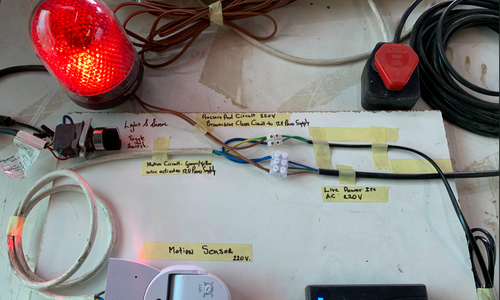
You will notice that I take live and neutral to the motion sensor, only live to the pressure pad and that I take neutral to the 12V DC transformer. If the pressure pad or motion sensor is activated, the transformer will receive current and switch on the alarm.
Pressure Pad
The pressure pad is a self-made device. The principle is that you use:
- Two sheets of aluminium foil, each having a wire taped to it.
- Separated by a section of foam or sponge that has holes in it.
- Enclosed in a waterproof sleeve.
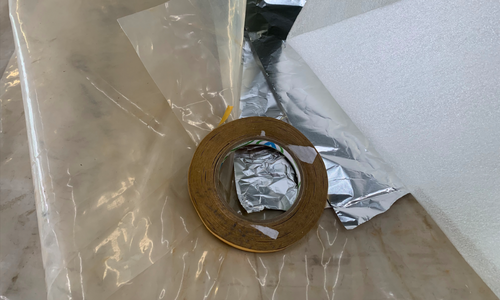
What you need:
- Aluminium foil – I use standard heavy kitchen foil.
- Strong plastic – I used repurposed plastic that came from old greenhouses. The plastic is thick, strong and UV stable and weatherproof.
- Foam or Sponges – I used packaging foam, but sometimes I also use old sponges. The foam keeps the foil layers apart but can compress under weight, allowing the foil to touch, closing the circuit and activating the alarm.
- Wiring – I use a 1,5mm two-core wire. The end is split open and taped to the foil.
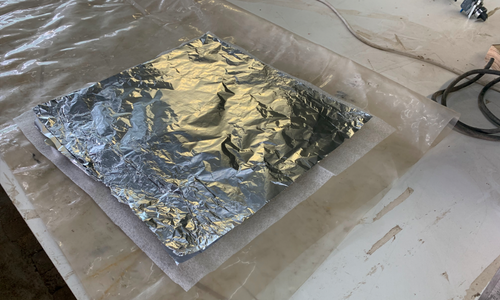
How to make:
- Cut two sections of aluminium foil of equal size.
- Fold the plastic in two, place one piece of foil on the plastic and cut the plastic 3 inches wider than the foil.
- Tape the wires to the foil.
- Cut the foam one inch larger (on all sides) than the foil.
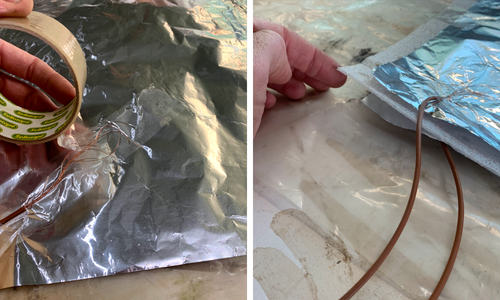
- Make holes in the foam. I used a soldering iron to burn holes in the foam. I tested the device and found it difficult to activate. So I made the holes larger until I got the sensitivity I needed.
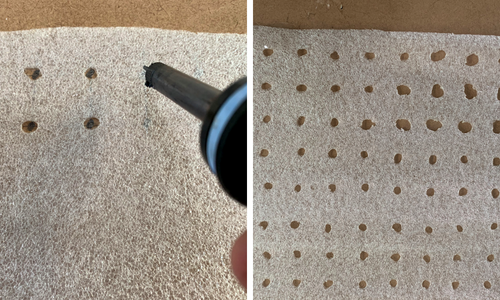
- Place a section of foil, then the foam, then the other piece of foil.
- Run lines of double-sided tape slightly wider than the foam and fold the plastic closed.
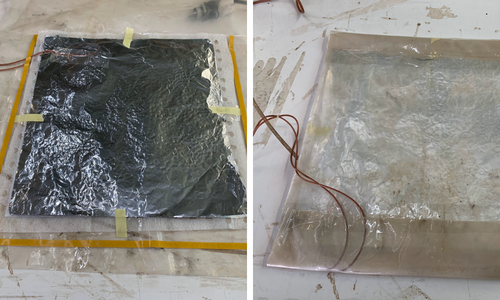
- Fold the plastic back on itself, creating a folded seal, and tape the edges flat. With the seal consisting of tape, the fold and the double-sided tape, it’s difficult, though not impossible, for water to get in.
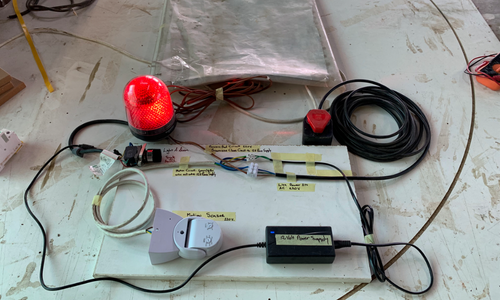
Going Off-Grid
Though the system depends on electricity, you could hook it up to your solar system. If you have a DC to AC inverter, your problem is solved.
⇒ Learn How To Produce Your Own Electricity At A Low Cost
But, let’s say you want to install the system somewhere you have solar but no inverter. For instance, maybe an off-grid shed, or you want to secure valuables when camping.
In the system I am describing, the pressure pad and signal light/alarm run on 12V DC but can also run on 24V DC and can be connected directly to solar.
The challenge lies only with the motion sensor. The motion sensor I use runs on 220V AC. Two solutions present themselves:
- The first is to use a 12V DC motion detector, in which case the wiring will look exactly as in the diagram, but you will leave out the 12V DC power supply.
- The second is to use a backpacker or camping inverter. I recommend owning one anyway, as these devices can come in really handy. Most of the appliances you already own use AC power. The DC to AC inverter will not only allow you to run this system while on the move or remotely, but you can use the inverter to charge your laptop or run a small radio or other devices without the need to buy specialized equipment. If you opt for this configuration, the wiring remains the same as in the images.
Some final remarks
- You can make the pressure pad as small or as big as your foil and plastic make allowance.
- Remember that the pressure pad is working with live current. Gardeners beware!
- The pressure pad can also be buried outside windows or placed under doormats.
- You can tweak the sensitivity of the pressure pad through the firmness and thickness of the foam or sponge and hole size.
So there you have it, folks. The system is a fun but effective way to ensure safety and security. The pressure pad has pros and cons but is very effective because most intruders will not, and cannot, be aware of it.

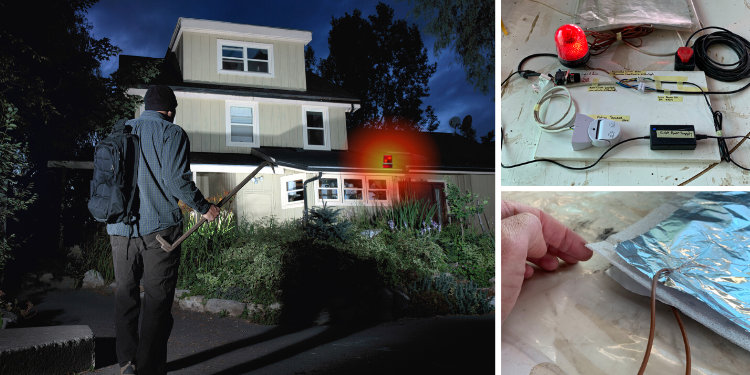




















Well, it’s an honest try for an article and not a cut and paste.
But you could do better buying off the rack items, test them and get a solid system up easier.
Security is a different thing than a burglar alarm. A flashing red light is mostly useful IF you have police protection OR neighbors that will actually get involved.
Being “Caught” lately in many areas has become a non-event as police often don’t even try to respond in a timely manner.
A trained dog is far more effective against sneak thieves and a small deterrent vs a drug addled tweeker. That and developing a working relationship with neighbors that will get involved and not peek out their windows as they load your stuff into a van.
Bad times coming, read Grahm’s Killhouse rules and get busy.
My security is putting up signs that my neighbors are unarmed and hide money under the bed.
You can get reasonable systems for not a lot of money.
However kudos to the author for showing how motion sensor works
Off grid to me is in a bugout camp where there is not a household electrical panel, just trees.
Although I find this article most interesting, my best bet for security here in the big city is anything that does not require electricity or depend upon technology. Those systems are for show, and you must have hard ware in place to back it up because as soon a things go down, you have nothing in place to protect you.
Rattle cans and trip wires ?
that works, tool
…and vice versa.
An audible electronic alarm in a shtf situation:
-Is a warning to people within earshot that you have electric power.
-Logical people will deduce that you have stuff worth protecting.
-Focus will shift to the source of the alarm, or where its cord is going to, possibly to nearby buildings. Or, where the signal is going to if wireless.
I think the smarter money is to use silent alarms for your own dwelling, audible alarms as decoys to draw undesirables’ focus elsewhere i.e. make somewhere else appear like it contains valuable stuff.
An alarm resulting in scoring bogus or low-quality loot I think will only serve to whet a bad guy’s appetite for a 10-block radius of careful searching.
I like the idea of the pressure pads. It’s a worthy effort. Expect humidity to bridge the circuit, though, eventually, unless sealed. How do I know that?
Picture in your mind a younger me, camping with his gf and dog in an old VW bus. Threw junk up in the front of the bus and on top of the horn button to make room to set the z-bed down in place – no matter, because the horn didn’t work. About 3:30-4AM, when the dew point hit, condensation bridged the gap in the horn’s electrical circuit and the horn started blowing. That was upsetting to myself, the gf, the dog, and everyone else who was asleep in tents around us in the campground. I had to extricate myself from comfort and get the stuff off of the horn button. Similar events could befall your pressure pads, also at inopportune times, unless anticipated in design.
Then you live to close to people
Population density will kill you
When I bought my property (40 acres and a house, two barns) there was nobody within a half mile of me. 22 years have passed and I am surrounded by very irritating neighbors who complain endlessly about farm animals and my tree farm collecting lightning strikes. They are from a big city with big McMansions and a big Liberal chip on their shoulders. There are times I think I am at the Alamo! I planted an extra 500 Trees, mostly white pine just to block them and their noise from what used to be a peaceful place. My original neighbors despise them too and have taken similar steps to screen out the liberal noises. What a mess!
Yeah time to make them leave
Small bells over doors and windows were once common and work without power.
I have a Mountain Xolo (aka village/common dog) that barks only when someone is close to the house. This is natural for the breed. They’re close kin to dingos and so on. The hairless breed was bred for temple guards. This one’s ancestors were used for packing and guarding traders’ homes and goods. They make good livestock guard dogs, common in Mexico). A neighbor has a female who likes to slip her collar and hunt coyotes. Pups are free in Mexico and very family oriented. niio
A little late if they enter the house
Please, what is niio?
My off the grid security system is as follows:
1) A Jack Russell that barks insistently and alerts me.
2) A cane corso mix that immediately investigates and doesn’t mind getting kinetic.
3) Me, with either a .45 acp or a .300 aac blackout in tote.
Hopefully you have your air Jordan’s on. Or a level 4 ceramic armor plate affixed to your chest.
My security system: my dogs.
Good info on the motion sensor. We have a split level with one double window downstairs. I bought a sheet of 5/8 plywood and keep it to cover this window. I have a truckers load lock for the front door, just prop it up against the door and the other end against the stairs. Back door has a smaller door stop that goes under the door knob and against the floor. These won’t keep out the very determined, but will slow them down long enough for the Marine Corps Vet to get in a good ambush position.
But what if they break and come through the windows?